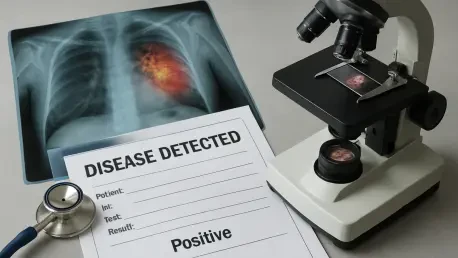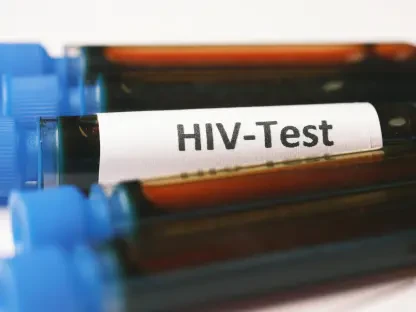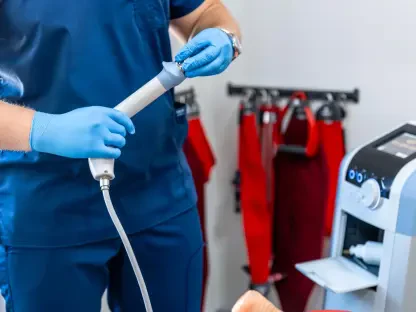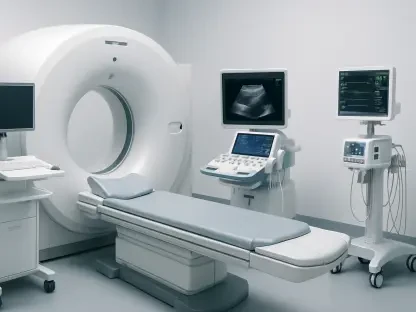Imagine a world where a single drop of blood could reveal the presence of life-threatening diseases like COVID-19, Ebola, or Lyme disease in just 15 minutes, all for the cost of a couple of dollars, making it an accessible and groundbreaking solution. This is not a distant dream but a tangible reality with NasRED (Nanoparticle-Supported Rapid Electronic Detection), an innovative diagnostic tool developed by researchers at Arizona State University. Emerging from the collaborative genius of the Biodesign Center for Molecular Design and Biomimetics and the School of Electrical, Computer and Energy Engineering, NasRED stands poised to transform the landscape of medical diagnostics. Its ability to detect a wide array of illnesses with unprecedented speed, affordability, and accuracy offers a beacon of hope for global health systems struggling with delayed diagnoses and inaccessible testing. This remarkable device could be the key to addressing some of the most pressing public health challenges, from infectious disease outbreaks to diagnostic errors that claim countless lives each year. As the world grapples with over 10 million annual deaths due to infectious diseases, the potential of NasRED to deliver rapid, low-cost testing in diverse settings—be it a remote clinic or a bustling urban hospital—cannot be overstated. The following exploration delves into how this technology could reshape disease detection on a global scale, highlighting its unique features and far-reaching implications.
Unleashing Speed and Accessibility in Diagnostics
NasRED’s defining strength lies in its ability to deliver diagnostic results in a mere 15 minutes, a stark contrast to traditional methods like PCR or ELISA that often require hours or days. This rapid turnaround is more than just a convenience; it’s a critical factor in managing infectious disease outbreaks where every moment counts. By enabling healthcare providers to identify illnesses almost instantly, NasRED facilitates immediate intervention, potentially curbing the spread of deadly pathogens in high-risk environments. Such speed could prove invaluable in emergency situations, ensuring that patients receive timely treatment before conditions worsen. The impact of this capability extends beyond individual care, offering a powerful tool for public health officials to track and contain epidemics with greater efficiency.
Equally transformative is the accessibility NasRED brings to the table. Designed to be portable and user-friendly, the device can operate in a wide range of settings, from under-resourced rural clinics to sophisticated urban medical centers. This adaptability addresses a significant barrier in global healthcare: the lack of advanced diagnostic facilities in remote or low-income areas. By eliminating the need for complex lab infrastructure, NasRED empowers local health workers to perform high-quality testing on the spot. This democratization of diagnostics could bridge critical gaps in regions where patients often face long delays or must travel great distances for basic medical assessments, fundamentally altering how care is delivered in underserved communities.
Breaking Financial Barriers with Affordability
At an astonishing cost of approximately $2 per test, NasRED redefines what affordable healthcare can look like, particularly for low- and middle-income countries where financial constraints often limit diagnostic capabilities. Traditional testing methods, burdened by expensive equipment and the need for specialized personnel, frequently place widespread screening out of reach for many populations. NasRED shatters these economic obstacles, making it feasible to conduct large-scale testing programs without straining public health budgets. This low price point could enable governments and organizations to prioritize early detection initiatives, ultimately saving lives by catching diseases before they progress to more severe stages.
Moreover, the affordability of NasRED holds the potential to shift the paradigm of health equity on a global scale. In regions where even basic medical services are a luxury, the ability to deploy an effective diagnostic tool at such a minimal cost could mean the difference between life and death for countless individuals. It supports the implementation of proactive health strategies, such as routine screenings for at-risk groups, without the prohibitive expenses typically associated with such efforts. By reducing the financial burden on both healthcare systems and patients, NasRED paves the way for a more inclusive approach to disease management, ensuring that economic status does not dictate access to life-saving technology.
Precision and Sensitivity Beyond Traditional Limits
NasRED sets a new benchmark in diagnostic precision, capable of detecting disease markers at concentrations nearly 100,000 times lower than what standard lab tests can achieve. This extraordinary sensitivity, surpassing methods like ELISA by a factor of 3,000, allows for the identification of illnesses in their earliest stages when only a few hundred molecules are present in a sample. For conditions such as HIV or hepatitis C, which are notoriously difficult to diagnose early due to low initial viral loads, this capability is nothing short of revolutionary. The ability to intervene at the onset of a disease can dramatically improve patient outcomes, preventing complications that often arise from delayed detection.
Adding to its precision, NasRED requires just a tiny sample volume—a single drop of blood or other bodily fluid—to produce reliable results. This minimal requirement not only makes testing less invasive for patients but also enhances the tool’s practicality in settings where collecting larger samples might be challenging. The combination of high sensitivity and low sample needs positions NasRED as an ideal solution for early-stage diagnosis across a spectrum of diseases. It offers healthcare providers a powerful means to catch illnesses before symptoms become severe, potentially reducing long-term treatment costs and improving survival rates for conditions that are treatable if addressed promptly.
Adapting to a Spectrum of Health Threats
One of NasRED’s most compelling features is its modular design, which allows it to be tailored for detecting an extensive range of diseases by simply adjusting the proteins on its nanoparticles. This versatility has already shown promise in identifying not only infectious diseases like African swine fever and COVID-19 but also non-infectious conditions such as cancer biomarkers and Alzheimer’s-related proteins. Such adaptability suggests that NasRED could become a cornerstone of personalized medicine, where diagnostics are customized to individual health profiles. This broad applicability enhances its value as a tool for both immediate crisis response and long-term health monitoring.
The potential for NasRED to address diverse health challenges extends its relevance beyond current medical needs, positioning it as a forward-thinking solution for emerging threats. As new diseases and variants continue to surface, the ability to quickly reconfigure the device for novel targets ensures that it remains relevant in an ever-changing health landscape. This flexibility could also support public health surveillance by enabling rapid adaptation during outbreaks or in tracking chronic conditions over time. By covering such a wide spectrum of applications, NasRED offers a glimpse into a future where a single diagnostic platform might handle an array of medical challenges, streamlining healthcare delivery across multiple fronts.
Harnessing Cutting-Edge Nanotechnology
At the core of NasRED’s groundbreaking performance is its innovative use of gold nanoparticles coated with antibodies and antigens, designed to interact with bodily fluids like blood or saliva. When a sample is introduced, these nanoparticles bind to specific disease markers, and an LED light coupled with a custom electronic detector analyzes their behavior to confirm the presence of an illness. This sophisticated mechanism underpins the tool’s exceptional sensitivity and speed, allowing it to detect even minute traces of disease-related proteins that traditional tests might miss. The integration of nanotechnology in this manner represents a significant leap forward in diagnostic capabilities.
This technological marvel not only enhances the accuracy of NasRED but also simplifies the diagnostic process, eliminating the need for bulky equipment or extensive lab setups. The compact nature of the detection system means that results can be obtained with minimal technical expertise, broadening its usability among healthcare providers with varying levels of training. Furthermore, the reliance on electronic detection ensures consistency and reliability in results, reducing the likelihood of human error. As a testament to the power of scientific innovation, NasRED’s design showcases how advanced materials and engineering can converge to address critical gaps in medical technology, offering a model for future diagnostic advancements.
Tackling the Global Burden of Disease
The implications of NasRED for global public health are profound, particularly in light of the staggering toll of infectious diseases, which claim over 10 million lives each year, predominantly in low-income regions. Delayed or missed diagnoses often exacerbate this burden, as treatable conditions spiral into fatal outcomes due to lack of timely intervention. NasRED’s rapid and accurate testing capabilities could significantly mitigate these losses by enabling early detection, especially in areas where healthcare infrastructure is limited. Its deployment could transform outbreak responses, allowing for swift identification and isolation of cases to prevent widespread transmission.
In addition to infectious diseases, diagnostic errors pose a major challenge, with nearly 800,000 individuals in the U.S. alone suffering death or permanent disability annually due to such mistakes. Many of these cases involve infections that could have been managed if caught early. NasRED’s precision and speed offer a potential remedy, ensuring that critical conditions are identified before they escalate. By addressing both the global epidemic of infectious diseases and the pervasive issue of diagnostic inaccuracies, NasRED stands to make a substantial dent in preventable mortality and morbidity, reshaping how health systems approach some of their most persistent challenges.
Bridging Healthcare Disparities Across Settings
NasRED’s design is uniquely suited to serve a variety of healthcare environments, from state-of-the-art hospitals in urban centers to makeshift clinics in remote villages. This scalability ensures that the benefits of advanced diagnostics are not confined to well-funded facilities but extend to regions where even basic testing is often unavailable. The device’s portability and ease of use empower frontline health workers to deliver accurate results without the need for extensive training or resources, addressing disparities that have long plagued global healthcare access. Such inclusivity could redefine standards of care in underserved areas, bringing critical medical insights to populations previously out of reach.
Furthermore, the ability of NasRED to function effectively across diverse contexts highlights its role in fostering health equity. In urban settings, it can streamline diagnostic workflows, reducing wait times and improving patient throughput. In rural or low-resource areas, it provides a lifeline where traditional lab-based testing is impractical. This dual applicability ensures that the technology meets the needs of varied socioeconomic landscapes, tackling both the logistical challenges of remote care and the efficiency demands of high-volume medical centers. By catering to such a wide array of needs, NasRED could help level the playing field, ensuring that quality diagnostics are a universal right rather than a privilege.
Reflecting on a Path Forward for Global Health
Looking back, the development of NasRED at Arizona State University marked a pivotal moment in the journey toward accessible and effective disease detection. Its blend of rapid results, low cost, and high precision tackled longstanding barriers that had hindered global health efforts for decades. The technology’s adaptability across a spectrum of diseases underscored its potential to address both immediate crises and chronic health challenges, offering a versatile tool for past and ongoing public health battles.
Moving ahead, the focus should shift to accelerating the miniaturization and automation of NasRED, potentially transforming it into a home-use test that further democratizes diagnostics. Collaborative efforts between researchers, policymakers, and healthcare providers will be essential to integrate this tool into existing systems, ensuring its benefits reach the most vulnerable populations. Investments in training and distribution networks could maximize its impact, while continued innovation might expand its applications to new health threats. Reflecting on this milestone, the path forward lies in building on NasRED’s foundation to create a future where timely, accurate disease detection is within everyone’s grasp, fundamentally altering the landscape of global health for generations to come.









